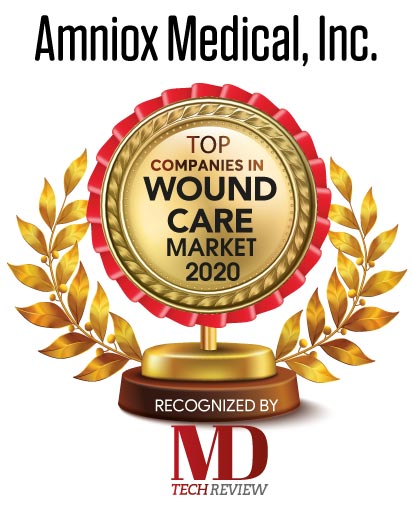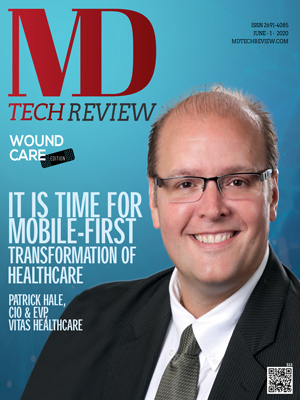 Herbert Slade, MD, FAAAI, Medical Director
Herbert Slade, MD, FAAAI, Medical DirectorIn the coming decades, people ≥ 65 years old will constitute the majority of diabetic patients in the U.S. and most other developed countries. It is estimated that, annually, foot ulcers develop in 9.1 million to 26.1 million people with diabetes worldwide and approximately 20 percent of moderate or severe diabetic foot infections lead to some level of amputation. Delayed wound healing of these ulcers is one of the single most common causes of lower extremity amputation among this population. Study results suggest that that cryopreserved human umbilical cord is a promising therapy for the management of complex, non-healing diabetic foot ulcers complicated by osteomyelitis. Amniox is currently focusing its research efforts on clinical trials to show how an investigational form of our umbilical cord product can potentially help patients with chronic, complex wounds. Results were recently published for our multicenter, open-label interventional Phase 2 Clinical Trial in patients with Wagner grades 3 and 4 complex diabetic foot ulcers (DFUs). The results indicate that cryopreserved human umbilical cord (TTAX01) is a promising adjunct therapy for the management of complex, non-healing diabetic foot ulcers complicated by osteomyelitis1. These results are comparable to previously reported results using the commercially available cUC NEOX® in a retrospective study2. In this study by Caputo, 26 of 33 (79 percent) of the wounds achieved complete wound closure in 16 ±9.3 (range: 4–44) weeks with 1.2 ± 0.4 cUC applications. The average wound size was 16 ± 18 cm2.
The CryoTek® process is a proprietary tissue-processing method that preserves the innate biological and structural integrity of the human birth tissue and therefore preserves and delivers natural properties of that matrix. Please walk us through this statement and shed some light on the Wound Care solution on the basis of its methodology, features and benefits involved.
CryoTek is a proprietary cryopreservation technology used to process our human birth tissue products. Amniotic membrane (AM) and umbilical cord (UC) tissue have long been recognized to exert unique anti-inflammatory, anti-scarring, and pro-regenerative properties on the ocular surface. A protein matrix component found in these tissues, heavy chain-hyaluronan/pentraxin 3 (HC-HA/PTX3), is believed to promote orchestration of inflammatory processes, support native stem cells, and inhibit myofibroblasts such that scarring may be reduced or absent in healed tissues. As such, these tissues have the potential to support wound healing at the cellular level and are suitable for use as a biological membrane without engraftment. To date, CryoTek cryopreservation has been the only method shown to effectively retain the HC-HA/ PTX3 complex.
As previously mentioned, study results of TTAX01 and the commercially available form of cUC, NEOX, indicate that umbilical cord is a promising adjunct therapy for the management of complex, non-healing diabetic foot ulcers complicated by osteomyelitis.
We are also pursuing the indication of spina bifida to support closure of the open spinal cord at the prenatal stage using cUC. This Investigational New Drug (IND) product, TTAX02, has received the Regenerative Medicine Advanced Therapy (RMAT) Designation and Orphan Drug Designation from the U.S. Food and Drug Administration (FDA) for the treatment of spina bifida in-utero. Additionally, it has been evaluated in four single treatment IND cases of in-utero repair of myeloschisis, the severest form of spina bifida, with outcomes to date comparing favorably at 12 months to the Management of Myelomeningocele Study (MOMS). Ramesha Papanna, MD, High Risk Pregnancy (MFM) Specialist, and his team at The Fetal Center at Children’s Memorial Hermann Hospital, McGovern Medical School at University of Texas in Houston obtained a single patient IND with Expanded Access and performed in-utero repair of large myeloschisis using cUC in a total of four human cases. All four myeloschisis patients were treated with cUC: two for skin defect closure, one for both skin and meningeal (dura) closure, and one for dura alone. In the three cases that received cUC for skin closure, complete healing was seen by 30 days with no wound dehiscence or CSF leakage, and minimal scarring.
There are a number of companies out there that are vying for the top position. What are the strategies employed by Amniox to thwart the market competition and what according to you are the distinct features of Amniox that gives it a competitive edge?
Under the leadership of TissueTech co-founders Amy Tseng, President & CEO, and Scheffer C.G. Tseng, MD, Ph.D., Chairman and Chief Technology Officer, Amniox is in the process of transforming into a biotherapeutics company and has opened several investigational new drug applications (INDs) to pursue the regulatory pathway to obtain Biologics License Applications. Our parent company – TissueTech – was the first company to introduce both amniotic membrane and umbilical cord human birth tissue for clinical application. The company has a track record of more than 500,000 patient transplantations to date and was responsible for helping to identify the unique potential of birth tissue in modulating inflammation and improving healing, HC-HA/PTX3. This complex helps orchestrate an ideal environment to support regenerative healing even in the most complex and chronic wounds.
What does the future hold for your organization? Any footprint expansion plans or platform enhancement strategies that you can shed light upon?
We will continue to foster innovation in new fields of use. We look forward to enhancing our product pipeline in orthopedics, podiatry, wound care, ophthalmology, optometry, urology, trauma, oncology, non-opioid pain management, and obstetrics/gynecology surgical subspecialties. We have demonstrated our investment in the future and desire to complete our transformation into a biotherapeutics company through the pursuit of rigorous IND clinical trials to support Biologics Licensing Applications, and raise the quality of evidence for Human Cells, Tissues, and Cellular and Tissue- Based Products. We feel based on the changing regulations and FDA guidance3, these strategies will be a key differentiator from other companies in the regenerative medicine space.
1. Marston, W. A., Lantis, J. C., Wu, S. C., Nouvong, A., Lee, T. D., McCoy, N. D., et al. (2019). An open-label trial of cryopreserved human umbilical cord in the treatment of complex diabetic foot ulcers complicated by osteomyelitis. Wound Repair Regen. 27, 680–686. doi: 10.1111/wrr.127542.
2. Caputo, W. J., Vaquero, C., Monterosa, A., Monterosa, P., Johnson, E., Beggs, D., et al. (2016). A retrospective study of cryopreserved umbilical cord as an adjunctive therapy to promote the healing of chronic, complex foot ulcers with underlying osteomyelitis. Wound Repair Regen. Off. Publ. Wound Heal. Soc. Eur. Tissue Repair Soc. 24, 885–893. doi: 10.1111/wrr.12456
3. https://www.fda.gov/regulatory-information/search-fda-guidance-documents/regulatory-considerations-human-cells-tissues-and-cellular-and-tissue-based-products-minimal
Company
Amniox Medical, Inc
Headquarters
Miami, FL
Management
Herbert Slade, MD, FAAAI, Medical Director and Amy Tseng, President/CEO and Scheffer C.G. Tseng, MD, Ph.D., Chief Technology Officer
Description
Amniox is currently focusing its research efforts on clinical trials to show how an investigational form of their umbilical cord product can potentially help patients with chronic, complex wounds. Results were recently published for the company’s multicenter, open-label interventional Phase 2 Clinical Trial in patients with Wagner grades 3 and 4 complex diabetic foot ulcers (DFUs). The results indicate that cryop reserved human umbilical cord (TTAX01) is a promising adjunct therapy for the management of complex, non-healing diabetic foot ulcers complicated by osteomyelitis. These results are comparable to previously reported results using the commercially available cUC in a retrospective study





